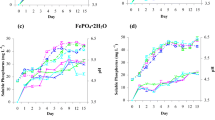Abstract
In a previous study, we evaluated the effects of inoculating rice plants with the phototrophic purple nonsulfur bacterium Rhodobacter capsulatus (Rc) on growth and yield of rice in pots and lysimeter experiments and the results obtained have been highly encouraging. In this study, we carried out two field experiments: one in the experimental farm of the Faculty of Agriculture, Fayoum University, and the second in a farmer’s field in Kafr El-sheikh, to assess the effects of Rc on growth and yield of rice in comparison and in combination with chemical nitrogen fertilizer (CNF) and farmyard manure. The results indicated that both biological and grain yields in all the Rc inoculated treatments were significantly higher than those in the uninoculated corresponding treatments in both fields. With regard to grain yield, the major factor for determining the effectiveness of any agricultural treatment, inoculation with Rc in combination with 50% of the recommended CNF rate gave a grain yield that was statistically equivalent to that obtained with 100% of the recommended CNF rate. These results provide a clear evidence for the potential of Rc as biofertilizer for flooded rice under field conditions.

Similar content being viewed by others
References
Choudhury AT, Kennedy IR (2004) Prospects and potentials for systems of biological nitrogen fixation in sustainable rice production. Biol Fertil Soils 39:219–227
Elbadry M, Elbanna K (1999) Response of four rice varieties to Rhodobacter capsulatus at seedling stage. World J Microbiol Biotechnol 15:363–367
Elbadry M, Gamal-Eldin H, Elbanna K (1999) Effects of Rhodobacter capsulatus inoculation in combination with graded levels of nitrogen fertilizer on growth and yield of rice in pots and lysimeter experiments. World J Microbiol Biotechnol 15:393–395
Freitez JR, Germida JJ (1992) Growth promotion of winter wheat by fluorescent pseudomonas under growth chamber conditions. Soil Biol Biochem 24:1127–1135
Habte M, Alexander M (1980) Nitrogen fixation by photosynthetic bacteria in lowland rice culture. Appl Environ Microbiol 38:342–347
Harada N, Nishiyama M, Otsuka S, Mastumoto S (2005) Effects of inoculation of phototrophic purple bacteria on grain yield of rice and nitrogenase activity of paddy soil in a pot experiment. Soil Sci Plant Nutr 51:361–367
IRRI (International Rice Research Institute) (2003) World rice statistics. http://www.irri.org/science/ricestat/index.asp
Kobayashi M, Haque, MZ (1971) Contribution to nitrogen fixation and soil fertility by photosynthetic bacteria. Plant Soil (Special Volume):443–456
Koh RH, Song HG (2007) Effects of application of Rhodopseudomonas sp. on seed germination and growth of tomato under axenic conditions. J Microbiol Biotechnol 17:1805–1810
Kondo K, Nakata N, Nishihara E (2004) Effect of purple nonsulfur bacteria (Rhodobacter sphaeroides) on the growth and quality of Komatsuna under different light qualities. Environ Control Biol 42(3):247–253
Kondo K, Nakata N, Nishihara E (2006). Effect of the purple nonsulfur bacterium Rhodobacter sphaeroides on fruit quality of tomato. In: xxxII International Horticultural Congress—IHC 2006
Ladha JK, Tirol-Pande A, Punzalan GC, Watanabe I (1987) Nitrogen-fixing (C2H2-reducing) activity and plant growth characters of 16 wetland rice varieties. Soil Sci Plant Nutr 33:187–200
Ladha JK, Tirol-Padre A, Reddy K, Ventura W (1993) Prospects and problems of biological nitrogen fixation in rice production. In: Palacios R et al (eds) New horizons in nitrogen fixation. Kluwer Academic Publishers, Dordrecht, pp 677–682
Lee KH, Koh RH, Song HG (2008) Enhancement of growth and yield of tomato by Rhodopseudomonas sp. under greenhouse conditions. J Microbiol 46:641–646
Maudinas B, Chemardin M, Yovanovitch E, Gadal P (1981) Gnotobiotic culture of rice plants up to ear stage in the absence of combined nitrogen source but in the presence of free living nitrogen fixing bacteria Azotobacter vinelandii and Rhodopseudomonas capsulatus. Plant Soil 60:85–97
Montano GL, Chan JS, Jarabelo RE, Pastor AB, Delacruz TE (2009) Isolation and characterization of purple nonsulfur bacteria (PNSB) from a rice paddy soil in Bulacan, Philippines. Philipp J Syst 3:57–67
Ranjith NK, Sasikala Ch, Ramana Ch (2007) Rhodethrin: a novel indol terpenoid ether has cytotoxic and phytohormonal activity by Rhodobacter sphaeroides OU5. Biotechnol Lett 26:1399–1402
Roger PA, Ladha JK (1992) Biological nitrogen fixation in wetland rice fields: estimation and contribution to nitrogen balance. Plant Soil 141:41–45
Serdyuk OP, Smolygiana LD, Kobzar EF, Gogotov IN (1993) Occurrence of plant hormones in cells of the phototrophic purple bacterium Rhodospirillum rubrum 1R. FEMS Microbiol Lett 109:113–116
Tsavkelova EA, Klimova SY, Cherdyntseva TA, Netrusov AI (2006) Microbial producers of plant growth stimulators and their practical use: a review. Appl Biochem Microbiol 42:117–126
Acknowledgment
The authors would like to thank Dr. Martin Krehenbrink (Oxford University, UK) for helpful revision.
Author information
Authors and Affiliations
Corresponding author
Rights and permissions
About this article
Cite this article
Gamal-Eldin, H., Elbanna, K. Field Evidence for the Potential of Rhodobacter capsulatus as Biofertilizer for Flooded Rice. Curr Microbiol 62, 391–395 (2011). https://doi.org/10.1007/s00284-010-9719-x
Received:
Accepted:
Published:
Issue Date:
DOI: https://doi.org/10.1007/s00284-010-9719-x




